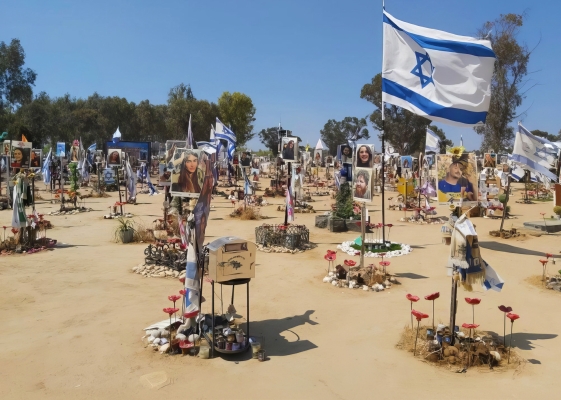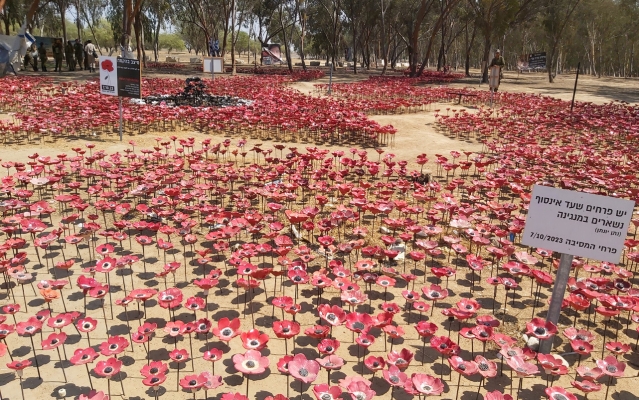Nova – Plain of Blood & Tears, The Day the Music Died
Text & Photos: Lydia Aisenberg
A group of fresh-faced new IDF recruits in uniform stand in close proximity to another uniformed group of somewhat older folk, actually veteran Israeli police officers, the expressions on their faces - whether young or not so spritely - reflecting the maelstrom of emotions each individually, and as a unified group, are struggling with.
The IDF and Israel Police personnel, plus a few score other Israelis and small group of American visitors on a solidarity mission to Israel, are paying homage to the 364 mostly young Israelis who lost their lives here, or in the surrounding area, as they desperately tried to flee the Nova Music Festival site near Kibbutz Reim on that dastardly evil, horrifying and tragic 7th October morning.
Almost a year later, as an eerie silence reigns over the Supernova Succoth Festival site, the body language of visitors transmits volumes of anguish as they attempt to absorb, disseminate and somehow emotionally deal with the enormity of the atrocities that happened here on this sparsely vegetated sandy, dusty plain wedged in between a number of kibbutzim, moshavim and towns situated close to the Israel-Gaza border.
People slowly move between small and large memorials created by the families and friends of those brutally massacred as hordes of hate- and drug-fueled armed to the teeth Hamas terrorists - and other Gazans who followed in their bloody footsteps – invaded, murdered and kidnapped to Gaza revelers from what had been a festival of joy, freedom and celebration of life through non-stop dance and trance music.
The impromptu large and small memorials to those that perished, and banners calling for the release of those from Nova still held captive in Gaza, covers an area roughly the size of two football pitches, most of it open to the sky but some parts copses of spindly trees and bushes giving little shade or cover in an hour of need.
Huge banners with images of a murdered party goer or those working at the festival either in security, catering or health services, have been strung up on high between tree trunks and as they gently flap to and fro in the wind, the images almost seem to come alive, smiles twitching, eyes twinkling in the sunlight as the banners ripples in the breeze.
Strikingly, the photographs depicting the victims chosen by their families and friends to be erected either on the banners or large information placards on poles hammered into ground at the site, are nearly all of their dearly beloved laughing, smiling or pulling funny faces - generating a visual collective of the beauty of youth, pulsating joy of celebrating life - all so horrifyingly cut short on the day that they, the dance and the music, died.
Underneath many of the banners are benches dedicated to that person or persons, or piles of stones - some inscribed with different messages, artwork or just names – all arranged as a temporary tribute and in some cases, headstones.
Hoardings in English and Hebrew, tell the stories of some of those who were murdered either trying to flee to more covered areas, or who had hidden in the lines of plastic and temporary public toilets, behind bars and catering facilities set upon site for the festival, or in or around their nearby parked cars.
There were also those who were discovered and murdered as they hid under piles of detritus in huge yellow metal dumpsters, their photographs and stories now hanging gallery style on the insides on the dumpsters that have been left on-site as part of the impromptu collective of memorials that have developed over the months, including an area of newly planted trees – a pole above each new JNF nurtured sapling holding a photograph of a victim.
There are so many tragedies within the tragedy of that October 7th Black Shabbat, including the realization of the large number of siblings or cousins who went to dance together and never came home. These include sisters Hodiya and Tahir David, and Gidi Chiel and his sister Noa. Of the four Rivlin brothers, Gideon (18) and Staff Sgt. Aviad (23) were murdered, but miraculously Yohai and Yinon managed to flee for their lives.
Alongside the individual memorials thousands of ceramic red anemone sculptures have been placed throughout the Nova site, , in a huge star formation and a few flowers also placed at the base of each post in the new sapling planted field of heartbreak.
The anemones, a flower that blossoms every year throughout large expanses of the Negev and particularly in the Reim forest region, serve as a metaphor for the young lives lost at Nova. The flowers were crafted and created by hundreds of ceramic artists throughout Israel and can also be found at other memorial sites such as the compound of burnt vehicles featured in the Jewish Telegraph.









Comments